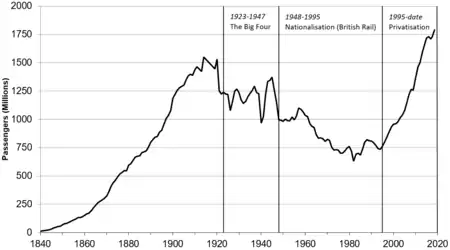Train overcrowding in the United Kingdom
Train overcrowding, technically known as "passengers in excess of capacity"[1] is a major source of public complaint about railway travel in the United Kingdom.[2] Large numbers of commuters have to stand on trains into and out of London, and other major cities, with more than a third of passengers standing on some services.[2][3] Public resentment about overcrowding, combined with the high prices of tickets, have made this a political issue.[4]

Most overcrowded services
As of 2014, of the ten most overcrowded train services, six were services to and from the London mainline stations London Paddington, London Victoria, and London Waterloo stations, three were services to or from Manchester Airport, and the other was part of the Thameslink Brighton to Bedford service,[5] passing through London Blackfriars station which, as of 2016, has been described as the most overcrowded in the country.[6]
Reasons for overcrowding
The growth in train overcrowding is largely attributed to increased passenger demand, and the 'walk-up' nature of British railways, in which seat reservations are not required,[7] combined with the inability to run extra trains due to the limitations of the current railway signalling system.[8] To resolve the latter problem, a transition to the European Train Control System (ETCS) is planned, which would allow many more trains to be run; by permitting them to be run closer together, while maintaining similar safety margins, potentially doubling capacity on some routes at busy times.[8]
Passenger demand can often reach up to double the available seat capacity.[9] Because of the different classes of train tickets, passengers with second class tickets often have to stand, even when empty seats are available in first class carriages.[10] Although reserved seats on many trains may be occupied if they are not taken up by the passenger who has booked them, many passengers are not aware of this.[11]
Solutions to overcrowding
To further increase rail transport capacity, there is a large ongoing programme of upgrades to the network, including Thameslink, Crossrail, electrification of lines, in-cab signalling, the Northern Hub, new inter-city trains, and a new high-speed line.
Other
In August 2016, Jeremy Corbyn, the Labour Party leader, was featured in a video showing him sitting on the floor of a train, in which he made a statement about overcrowding. The video, and the subsequent controversy regarding it, became known as 'Traingate'.[12][13]
See also
References
- "Rail passenger numbers and crowding on weekdays in major cities in England and Wales: 2014" (pdf). GOV.uk. Rail Exectutive. 9 September 2015. Retrieved 29 August 2016.
- Hyde, Dan (9 September 2015). "Revealed: Britain's most overcrowded train lines". The Telegraph. Retrieved 29 August 2016.
- "Six of top 10 most overcrowded peak train services reach busiest point in London". ITV News. ITV plc. 28 July 2016. Retrieved 29 August 2016.
- "Rail users should get a seat in 20 minutes says minister". BBC News. British Broadcasting Corporation. 30 October 2014. Retrieved 29 August 2016.
- "England and Wales 'top 10' overcrowded train services: autumn 2014" (PDF). GOV.uk. Rail Executive. Autumn 2014. Retrieved 29 August 2016.
- Bastable, Bex (28 July 2016). "Brighton to Bedford service named most overcrowded in the country". Brighton & Hove Independent. Retrieved 29 August 2016.
- Westcott, Richard (24 August 2016). "How many people have to stand on trains?". BBC News. British Broadcasting Corporation. Retrieved 29 August 2016.
- Quine, Adrian (29 May 2016). "Could we finally see the end of overcrowded trains?". BBC News. British Broadcasting Corporation. Retrieved 29 August 2016.
- Hughes, Laura (28 July 2016). "Revealed: Rail passengers suffer unbearable levels of overcrowding as trains cram in twice the number of people they should". Daily Telegraph. Retrieved 29 August 2016.
- Rayner, Gordon (13 October 2013). "Scrap first class to give more train passengers a seat". The Telegraph. Retrieved 29 August 2016.
- "Who, What, Why: When can you sit in a reserved seat on a train?". BBC News. British Broadcasting Corporation. 24 August 2016. Retrieved 29 August 2016.
- Bolzen, Stefanie (25 August 2016). "Sitzplatz im Zug: Wie dem Labour-Chef sein „Bahn-Erlebnis" entgleist". Die Welt (in German). Retrieved 29 August 2016.
- Walker, Peter (25 August 2016). "Traingate latest: Jeremy Corbyn gets seat on Glasgow service". The Guardian. ISSN 0261-3077. Retrieved 29 August 2016.
External links
- "Rail passenger numbers and crowding statistics: notes and definitions" (pdf). GOV.uk. Department for Transport. 2012. Retrieved 29 August 2016.